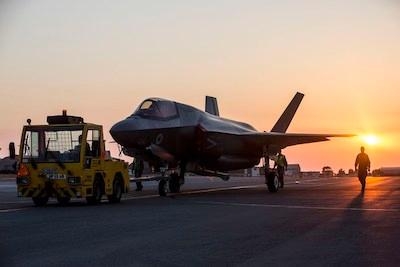Sun, Jan 21, 2024
Improper Procedural Adherence, Rushed Equipment Checks, Clunky Interfaces Blamed for Ruined Engine
A team in the 62nd Aircraft Maintenance Unit at Luke AFB slipped up while executing a Time Compliance Technical Directive for an F-35A aircraft, allowing a ground-run engine to ingest a handheld flashlight.

The error "damaged the $14,000,000 engine beyond local repair" according to the investigative report, though the replacement parts required should be a comparably cheaper $3,900,000. The maintenance was intended to install a metering plug as required after an F-35B mishap in December of 2022.
"To complete the TCTD, the team removed a panel and inserted a metering plug into an engine fuel line. They prepared the aircraft for an engine run to test the installed metering plug for fuel leaks. The engine run was completed with no visual indications or health reporting codes that would indicate an abnormal engine run. Once the engine was shut down, the MT reported hearing a noise from the decelerating engine. A post-engine run inspection was completed by mishap member 1. The inspection noted significant damage to the engine."
"The Board President found by a preponderance of evidence that a handheld flashlight caused the damage to the aircraft. An incomplete tool kit inventory and failure to comply with Joint-Service Technical Data guidance, prior to engine start, resulted in the FOD. The Board President found that F-35 Autonomic Logistics Information System checklist complacency and a disconnect between Department of the Air Force Instruction 21-101 tool inventory guidance and unofficial local procedures were contributing factors to the mishap."
Riding along with the narrative is a nod to the difficult interface and worry layout of the ALIS maintenance system. That “Autonomic Logistics Information System” sounds great in theory, but the personnel on the ground always find the easiest way around an obtuse system. The investigation notes that the Portable Maintenance Aids used to guide the installation are “not optimized to conduct flightline maintenance”, since the ALIS suite was designed as a whole-aircraft diagnostics and logistics ecosystem. In practice, a lack of network connectivity on the flightline means teams have to run back and forth to a networked building to update their electronics and forms. That post-hoc documentation leads to complacency, since logging is done long after the job is complete, and correct procedure is assumed after the fact.
On top of that, the electronics inhibit easy flightline maintenance with a byzantine workflow. The checklist used in the botched installation was only one of many required to be referenced - in total 15 discrete checklists were needed for reference. The need to scan and scroll through a mountain of data also causes complacency, according to the investigation. Luckily for the teams, ALIS will one day be replaced by ODIN. That unit replaces the 800-lb ALIS computer with 100 lbs of processing power…but no word has really been said in regards to workflow improvements.
More News
From 2023 (YouTube Edition): An Even Faster Rolling Extra! Jim Campbell joined General Manager of Extra Aircraft Duncan Koerbel at AirVenture 2023 to talk about what’s up and>[...]
“Receiving our Permit to Fly and starting Phase 4 marks a defining moment for Vertical Aerospace. Our team has spent months verifying every core system under close regulatory>[...]
Middle Marker A marker beacon that defines a point along the glideslope of an ILS normally located at or near the point of decision height (ILS Category I). It is keyed to transmit>[...]
The Experienced Pilot Chose To Operate In Instrument Meteorological Conditions Without An Instrument Flight Rules Clearance Analysis: The airplane was operated on a personal cross->[...]
Also: ATI Strike Prep, Spirit Still Troubled, New CubCrafters Dealership, A-29 Super Tucano Samaritan’s Purse is officially moving its historic Douglas DC-8 cargo jet into re>[...]
 Classic Aero-TV: Extra Aircraft Announces the Extra 330SX
Classic Aero-TV: Extra Aircraft Announces the Extra 330SX Aero-News: Quote of the Day (11.15.25)
Aero-News: Quote of the Day (11.15.25) ANN's Daily Aero-Term (11.15.25): Middle Marker
ANN's Daily Aero-Term (11.15.25): Middle Marker NTSB Final Report: Lancair 320
NTSB Final Report: Lancair 320 Airborne 11.14.25: Last DC-8 Retires, Boeing Recovery, Teeny Trig TXP
Airborne 11.14.25: Last DC-8 Retires, Boeing Recovery, Teeny Trig TXP



